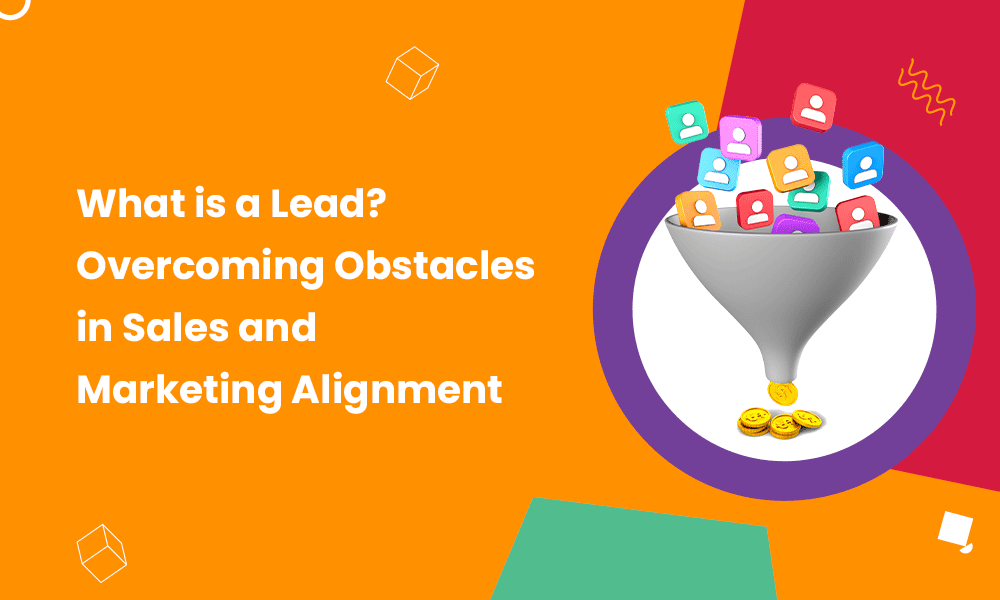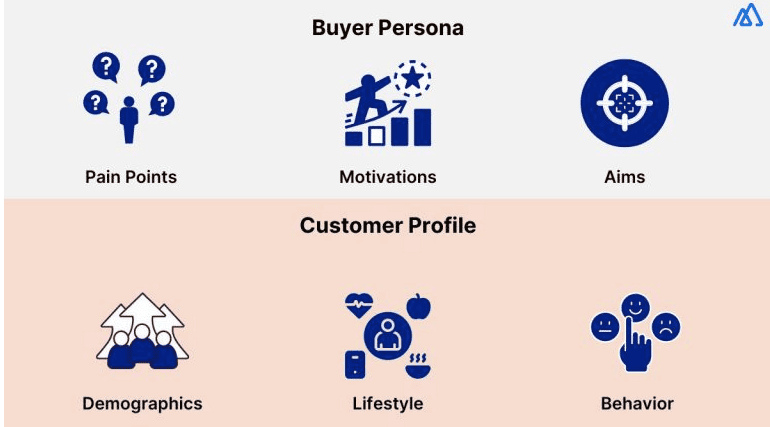Marketers would agree with me that lead generation is a lot like fishing. You must use the perfect bait and slowly reel in the fish at the right time. And, we can’t even predict if it’ll take a few minutes or several days!
But, would your sales team agree with this story about lead generation? If you’re not sure, this article is for you.
When there’s a misalignment between sales and marketing teams, companies lose $1 trillion annually! And, the average B2B company loses 10% of its annual revenue because of this misalignment. That’s no small amount. 😳
By the end of this article, you’ll get a head start on lead generation and sales-marketing alignment (aka smarketing). We’ll give you a detailed breakdown of:
- What exactly is a lead?
- Why lead qualification is crucial to generate more revenue
- The differences between MQLs and SQLs
- Common causes of MQL-SQL misalignment
- 10 simple steps to improve marketing-sales alignment
- A case study of American Express
If this sounds good to you, read on!
Table of Contents
What is a Lead?
A lead is simply an individual who’s likely to be interested in eventually buying the product or service you’re selling.
There are many ways an individual could “show interest” in your services. Some of the common ones are:
- Downloading a lead magnet
- Filling up a form for a demo
- Signing up for your newsletter
- Messaging you on social media
- Ringing up your sales team directly
Lead generation is the process of converting visitors to your website or other pages into loyal customers who spend their hard-earned dollars on your product.

But, here’s where it can get complicated for your sales and marketing teams.
Are both teams aware of how you define a marketing-qualified lead (MQL) and a sales-qualified lead (SQL)? Can your sales team convert enough leads once you hand them off?
If you’re struggling with these issues, then it’s time to take action. This misalignment causes both your marketing and sales teams to lose out on time and money.
And, that’s why better lead scoring and lead qualification practices can become an absolute game changer for your company.
Let’s dig deeper.
Read also: The Lead Generation Process — How Does It Work?
What Exactly is Lead Qualification?
Not all leads are created equal. That’s why nailing your lead qualification process can set you up on a firm foundation.
Lead qualification is the process of measuring and predicting if your new lead is interested and capable of purchasing from your company.
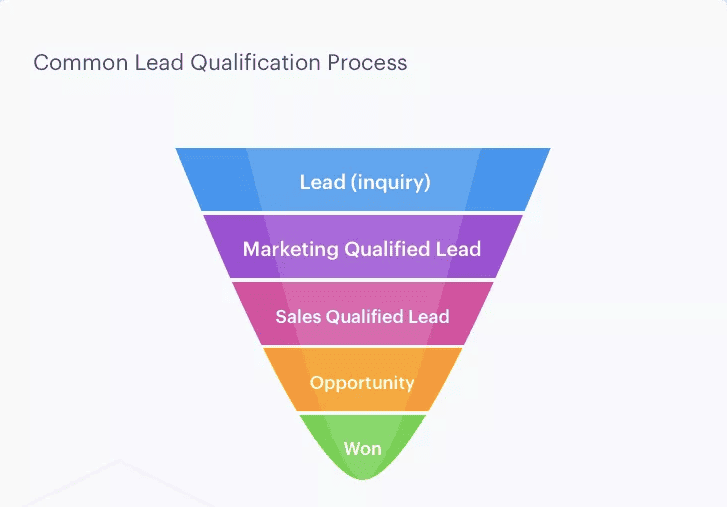
This way, you spend more time and money on leads who are more likely to become loyal and valued customers in the future. And, it’s perfectly normal to put some leads on the back burner.

But, wait … how can lead qualification help you?
Going into today’s market without lead qualification is like hunting at night. It’s possible, but not recommended. Here’s how a lead qualification process can help.
Spend time and effort on the right leads
When your lead qualification process is accessible, logical, and well-defined, it’s going to create unity between sales and marketing.
You know exactly which leads you’ll need to spend more effort to nurture. In the long run, lead qualification helps you use your resources for high-value tasks.
Improve conversion rates and boost revenue
Once you spend your money and efforts on targeting the hot leads, your conversion rates are likely to improve. How does this boost revenue?

Studies show that companies spending more on lead nurturing end up with 50% more sales and a 33% drop in acquisition costs. You’ll also improve the overall customer lifetime value.
Personalized content creation is easier
The lead qualification process gives you a clear picture of where each lead stands. So, you’ll be able to send targeted and personalized marketing content to the right lead at the right time.

Studies have proved that personalizing the lead nurturing process can lead to a 57% increase in engagement and a 63% increase in conversions.
And once your sales and marketing teams are in sync, your sales team will also be able to personalize offers and sales scripts to close the deal.
Troubleshoot your sales funnel
Another advantage is getting deeper insights into your sales funnel health. And, it becomes easier to identify underperforming segments and troubleshoot your sales funnel.
Read also: A Beginner’s Guide to Lead Funnels: How to 2X Your Sales
How do I get started with lead qualification?
To qualify or not to qualify…that is the question. If you’re wondering how to get started, read on. Advanced players can skip to the next section.
1. Do your research
This is one of the most important steps. There’s a lot that can go into your research. Here’s what we recommend for beginners:
- Ensure that you have complete customer profiles of all your leads from different sources. Once you have this, gather all your data into one central platform like EngageBay’s CRM solution for easy access and accuracy.
- Pull up your website visitor data from Google Analytics or a similar platform. You’ll need to do in-depth research on the average time spent on your website, the demographics of your average customer, interests, and preferences, and their behavior on your website.
- If you are a B2B company, look for additional information like the key decision-makers in the company, the company’s trajectory of growth, and funding information.
- Gather data across different channels like social media, YouTube, and LinkedIn. Take the help of tools like Facebook Audience Insights and get a clear picture of your target audience.
2. Optimize your lead scoring model
At this stage, you’ll need a clear picture of your ideal customer profile (ICP). Don’t worry, we’ll show you how to develop ICPs in the next section.
After this, you can begin your lead-scoring process.
Lead scoring is nothing but assigning values (or numerical points) to leads to determine the perceived value of the lead to your organization.
These assigned points will help your sales and marketing teams understand exactly where the lead is placed in the sales funnel. And, this will also help you contact or nurture the right lead at the right time.
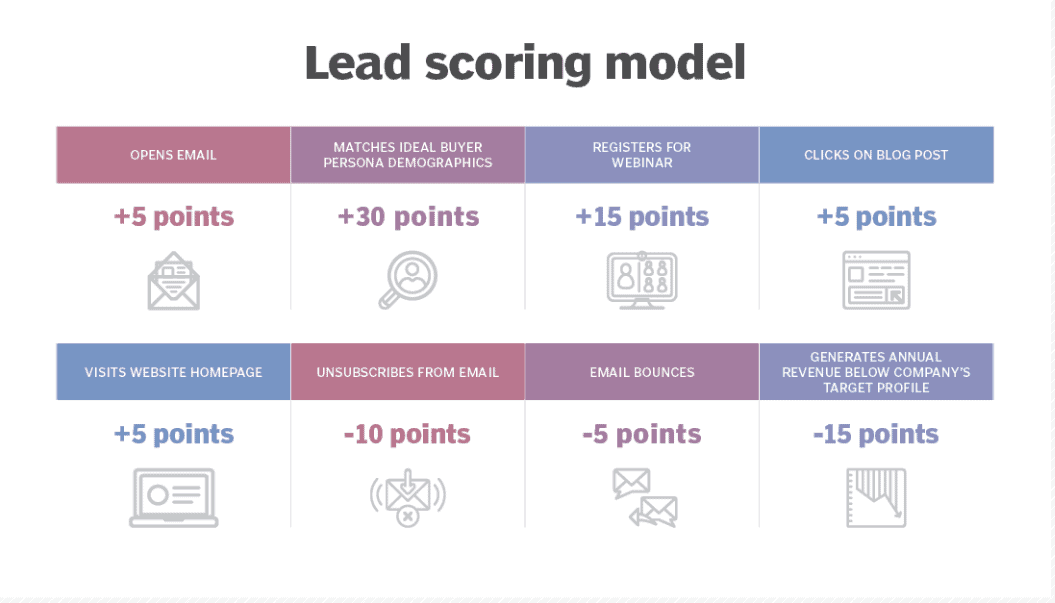
Remember, each company determines its threshold for an unqualified lead. This is where sales-marketing alignment becomes so crucial.
If your sales and marketing teams don’t see eye to eye on this threshold, then it can spell trouble for your organization. We’ll show you exactly how to combat this problem. So, keep reading!
👉Master the art of sales lead management with our expert guide – explore best practices and strategies now! 🌟
3. Select the right lead qualification framework
The next step is for you to choose the right lead qualification framework that suits your needs. There are several frameworks to choose from — each with its advantages and disadvantages. Here’s a snapshot of the most popular frameworks. 👇

4. Don’t ignore all unqualified leads
Once you’ve got qualified leads, this doesn’t mean that you just ignore other leads. When organizations take an attitude that says “You don’t fit our ICP, so we can’t help you” — it can cause you to lose out on business.
Of course, we’re not saying that you have to invest a lot of money and energy in unqualified leads. But also don’t write them off completely. After all, situations can change rapidly.
These steps will help you get started with lead qualification. But, there can be bigger issues with your lead qualification process.
Read also: The Ultimate Guide to Creating Lead Magnets, and Why You Need Them
Is There Any Real Difference Between MQLs and SQLs?
Let’s look at a common scenario.
The sales team is frustrated because very few of their marketing leads are sales-ready. As a result, sales reps often ignore several leads given to them by the marketing team.
The marketing team is frustrated because they’ve spent much time and energy nurturing these leads. To them, it feels like the sales team doesn’t take the initiative to reach out to these leads. Each team blames the other for the lack of conversions.
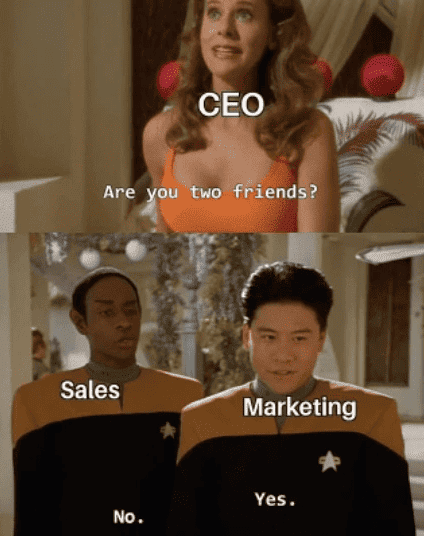
The result? Nobody takes responsibility for their contribution to the problem or for creating a real solution — leading to revenue loss for the company.
Instead, imagine if your sales and marketing teams could sit together to identify marketing-qualified leads (MQLs) and sales-qualified leads (SQLs). In this case, only marketing leads who meet certain pre-set criteria will be handed off to the sales team. This makes both your teams more effective in the long run.
Read also: 6 Easy Ways to Spot (& Create) New Sales Opportunities Like a Boss
Top 4 Red Flags 🚩For Marketing-Sales Misalignment …
If you’re unsure if your sales and marketing teams are in alignment, here are our top 4 red flags you need to look out for. Don’t ignore them and let the problem fester. If you see this playing out in your office, it’s time to take action.

- Low conversion from MQLs to SQLs. This is a sure sign that your teams aren’t seeing eye-to-eye. This indicates that there’s an issue with lead nurturing, sales calls, or your lead hand-off process.
- Marketing and sales teams don’t know what the other is doing. If your marketing team isn’t aware of the sales team’s targets and vice versa — it’s a bit like rowing a boat in opposite directions. This can be fixed with better communication and accountability.
- Your sales team feels that inbound leads lack brand/product awareness. You’d be surprised at how many businesses struggle with this. This highlights a lapse in the lead nurturing process.
- Your marketing team feels like the sales team is ignoring too many leads. When the sales team ignores too many leads — it’s a case of throwing the baby out with the bath water. Better communication and alignment can easily resolve this.
Read also: Top 11 Sales Tools For Effective Lead Generation
Why Your MQLs and SQLs Could Be Misaligned …
Now that you can identify the problem, let’s look into the most common causes of MQL-SQL misalignment.
- No clear definition of a qualified lead for sales and marketing
- Ineffective or incomplete buyer personas
- Issues in the lead-scoring process
- Lack of shared goals between sales and marketing
- Ineffective communication between the two teams
Here’s a bit of info on the results of this misalignment to your company 👇
Here’s how you can fix this misalignment in your company.
Read also: Lead Scoring Model to Close More Deals
10 Steps for Better Sales-Marketing Alignment in Lead Generation
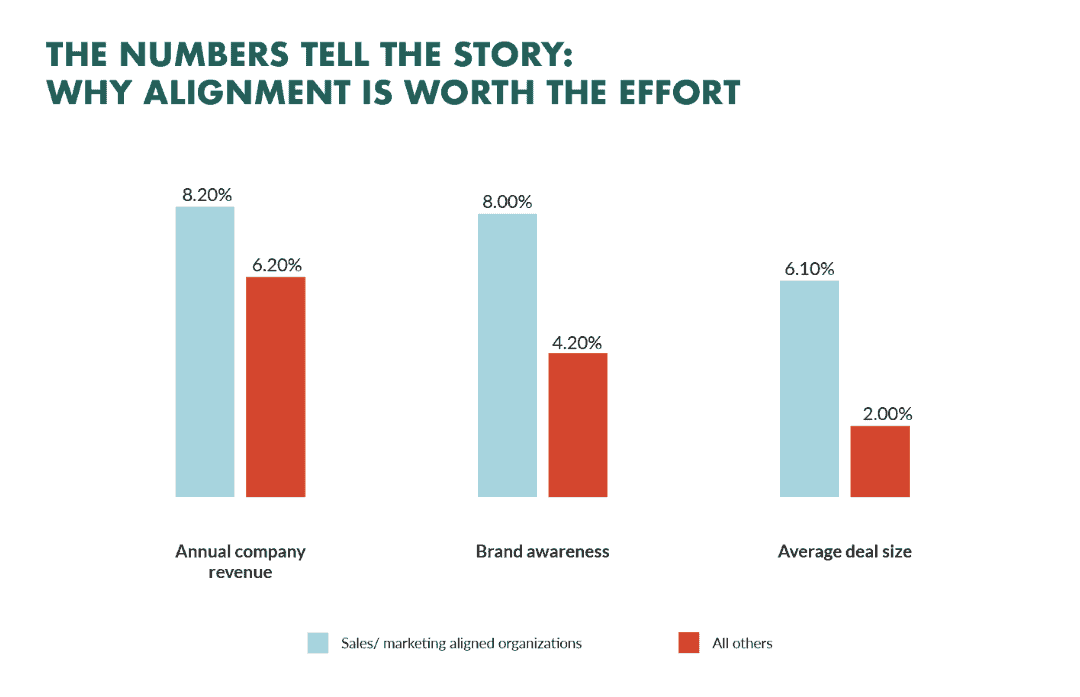
Think of your sales and marketing teams as the yin and yang of your office. When these energies combine, your company gets balance, unity … and more revenue! Here’s how you can fine-tune it.
1. First, get clear on your marketing and sales goals
Let’s start with a stable foundation. Sometimes, this can mean returning to the drawing board and clarifying your goals and company values.
Here, it’s not just enough to set goals. You’ll also need to set shared goals for the sales and marketing teams, depending on your sales funnel and stages of the customer journey. This may seem like a small step, but it’s important.
2. Understand your target buyer by creating buyer personas and ‘unideal personas’
You’re ready to create buyer personas and ideal customer profiles (ICP) at this stage. Remember, they’re not the same thing. A buyer persona is different from a customer profile. 👇
An obvious symptom of sales-marketing misalignment is mismatched ICPs. This not only sets up both teams to fail but also provides a poor customer experience. Misalignment also leads to poor lead quality down the road.
Once you’ve created ICPs that are aligned with your overall goals and sales cycle, consider creating some ‘unideal’ personas. These are leads who are not very likely to convert to paying customers.
To start with this step, gather all your data in one place. Conduct surveys and collect customer feedback to identify pain points for your buyer personas. At this stage, customer profiling software or a CRM platform can help.
Read also: Maximize Your Sales: Top 12 Lead Scoring Tools Reviewed
3. Optimize lead scoring and set the criteria for MQLs and SQLs together
For this step, involve both your teams. This boosts motivation and gives both teams a sense of responsibility and autonomy about their goals.
Leads can be scored based on behavioral patterns, their stage in the customer journey, and their fit to your company. At this stage, your sales and marketing teams should be able to see eye-to-eye on what defines a good lead.
Typically, MQLs are leads that the marketing teams believe would be ready to buy in the future. They’re usually at the top stages of the sales funnel. SQLs are leads that the sales teams are almost ready to buy.
A sales accepted lead (SAL) is a lead that’s acknowledged by the sales team who are working on closing the deal. Both teams must collaborate on the ‘consideration’ stage of the buyer journey. 👇

Here, the “winning zone” is where your sales and marketing teams can collaborate to drive the lead to the decision stage of the buyer’s journey.
Read also: Lead Nurturing Campaigns By Top Brands Like Kate Spade
4. Map each stage of the buyer’s journey with incremental behavioral commitments
Once you’ve set your criteria for classifying MQLs and SQLs as a team, your real work begins.
Now, you’ll need to make two changes:
- The first is a shift from a transactional focus to a customer focus. This means that your company learns to see its products from the customer’s POV.
- The second is mapping your buyer’s journey with “incremental customer behavioral commitments“.
It’s way easier than it sounds, so bear with me while we break these concepts down. 😅
In a transactional focus, you have your typical sales funnel. Here, a lot of time, and effort are poured into the top of the sales funnel for a few deals that come out at the end of the sales funnel.
This is the primary reason why sales and marketing teams are even able to function separately.
But, in a customer-focused company, the buyer’s journey is mapped out carefully based on your ideal customer’s buying process. You must discover what drives or motivates the lead to make an incremental commitment at each stage.
What do we mean by incremental commitment? This is an action or behavior exhibited by the lead that shows you their increasing interest in your product.
So, at this stage, spend time carefully mapping out your buyer’s journey based on incremental behavioral commitments. Here’s what this would look like. 👇
5. Assign and divide responsibilities for each stage of the sales funnel and pipeline
This is a simple yet underrated step.
Once you have your buyer’s journey mapped out, you can begin assigning responsibilities for each stage of the buyer’s journey to the right team or person.
This means that your sales and marketing teams know exactly what they must do and when.

But, we recommend going one step further. How would you do this?
Break down each stage of the funnel into smaller stages or activities and decide on the actions that can be taken at each stage. Then, assign each activity to a team member based on their strengths.
6. Integrate your CRM and marketing automation platforms to create content that resonates with your buyers
Let’s face it — automation can be your savior in marketing-sales alignment. How does it work?
Setting up automated workflows that can take a specific action based on pre-set criteria is quite easy. For example, let’s say that you’ve assigned a lead score of 5 for the first homepage visit, and a score of 15 for leads who downloaded a lead magnet.
You can then track all the website visits and downloads and automate the process of assigning scores. Once a lead has reached the SQL threshold, your marketing team will be notified of the sales-ready lead.
Your automation platform can directly send information to the Customer Relationship Management (CRM) platform used by your sales team. Your sales team can then track levels of engagement at each stage. This includes pages viewed, past behavior, and content downloads. This can help the sales team tailor their approach for each lead.
Here’s how it looks on EngageBay’s all-in-one CRM platform.👇 EngageBay integrates automation for your sales, marketing, and customer service teams in one intuitive platform.
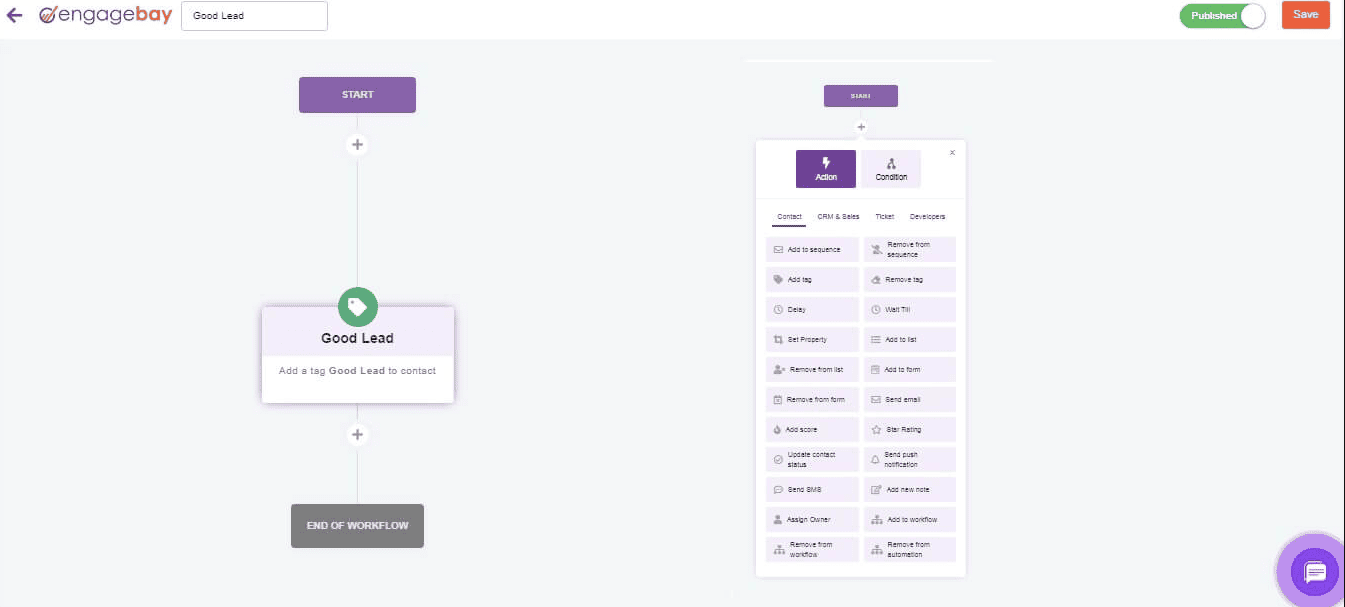
7. Create a new lead hand-off process with clear criteria
Nailing the lead hand-off process can make or break your conversion rates. You’ve already optimized your lead qualification and scoring process at this stage and integrated it with your CRM platform.
Now, you’re ready to train the sales and marketing team on qualification criteria, tracking the right KPIs, and lead management features on your CRM system.
Then, create a lead hand-off agreement. Only leads who meet a pre-set threshold should be considered for the hand-off. And, the marketer can specify the actions they expect the sales team to take on this lead.
Once there’s a sales-approved lead (SAL), the sales team can act. Tracking SALs can show you further issues with the hand-off process.
It doesn’t have to be as complicated as this cartoon, though.👇 So keep it as simple as possible and don’t overwhelm your team. 😹

8. Measure the right KPIs and metrics based on your sales pipeline
At this stage, make sure that every key performance indicator (KPI) is relevant to your sales pipeline. You’ll have to pick the right KPIs for each stage. We highly recommend that both teams decide on marketing and sales KPIs together.
You’ll have to dig deep and go one step ahead of tracking foundational KPIs like customer acquisition cost, customer lifetime value, and conversion rates.
Read also: 17 Powerful Techniques to Generate B2B Sales Leads
9. Improve effective communication between your sales and marketing teams
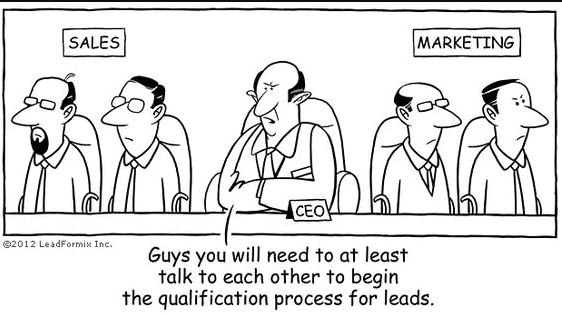
Poor communication between teams is often a silent killer of motivation. Here are some ideas to help you break the ice and get the two teams working in sync.
Use a shared dashboard or CRM system
If you don’t have this important feature…get it now!
Both teams can track engagement and projects in real-time with a shared dashboard or CRM system. This will help you prevent miscommunication and efficiency. And, you can seamlessly transfer data about lead behavior.
Use training sessions to break the ice
Consider implementing some joint training sessions for the sales and marketing teams. This way, each team sees the other as a collaborator rather than a detractor. It also helps both teams understand best practices and take ownership of the goals they’ve set.
Schedule joint meetings every week or month
Set up regular meetings with both teams present. Here, both teams can talk about their goals and their progress. It’s a great way to encourage teams to share their ideas, solutions, and feedback. After all, they say two heads are better than one!
Celebrate all your wins together!
Whether you’ve closed a huge deal or drafted a killer marketing plan — celebrate your wins together. This fosters a sense of well-being and camaraderie among both teams.
Create a buddy system to stay accountable
Pair up a sales team member with a “buddy” from the marketing team. Ideally, this should be someone they collaborate with regularly. The buddies can check in with goals, remind each other of shared goals, and share their expertise.
Once your internal communications system is sorted, you’re ready to collect feedback.
Read also: Lead Scoring Strategy to Discover & Prioritize High-Value Prospects
10. Collect feedback and keep improving this process
Send regular anonymous surveys to your sales and marketing teams. Collect feedback on your sales-marketing alignment during meetings and training sessions. This wealth of data will tell you exactly where your teams are struggling. Then, it’s up to both teams to implement and improve their tactics.
That’s it, folks! Once you give it some time, these ten steps will align two warring teams. We hope you found some value in these ideas.
Read also: The Hidden Revenue Opportunity In Sales And Marketing Alignment
Case Study of Marketing-Sales Alignment Success: American Express
American Express has held a lofty goal of becoming an international leader in the corporate travel industry. They aimed to create quality content to help establish themselves as an industry leader.
Let’s look at some of the great ideas they implemented.
Their goal was to create excellent and helpful content to inform companies about business travel and its many challenges and solutions. They partnered with the Global Business Travel Association (GBTA) to conduct extensive research on the technological and management challenges in the industry.
American Express launched a pilot social selling team. This team included key sales, marketing, and PR team members. Here’s what American Express’ Director of Strategy and Business Planning had to say 👇

Behind the scenes, these teams conducted extensive surveys to understand customer pain points. This way, the team was able to provide the company with extensive consumer feedback.
Finally, they were able to launch content that performed extremely well. They also leveraged their original research, curated infographics, started a social selling campaign, and created digital events to generate a buzz. Here are the results:
- American Express garnered a reach of more than 100 million publications and over 1,500 organic visits.
- On average, they were able to boost their engagement rates by 100% compared to industry standards.
- Most of their traffic was organic
- 20% of the content hub followers are AmEx employees who continue to boost engagement.
Read also: What Is a Webinar and How to Use It for Lead Generation
Wrapping Up
We’ve seen that sales-marketing alignment is a big deal if you want to establish yourself as a leader in your field. And, you’ll make more revenue too!
Remember that the bottom line of any lead generation program is creating an excellent relationship with your customers. Don’t lose sight of this. Let us know your thoughts in the comments below!
